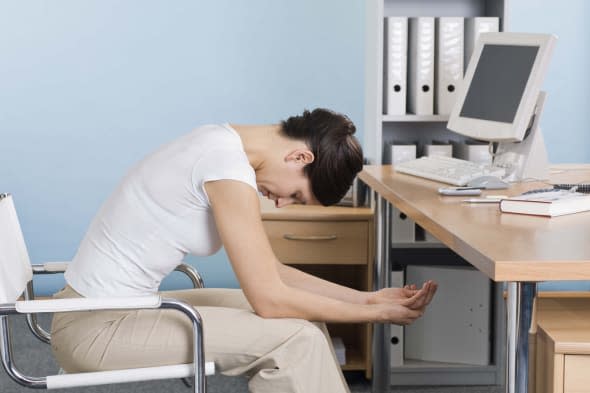Sitting desk stretches to improve posture

Studies show that sitting for extended periods is as bad for our health as smoking or a poor diet, and desk workers know only too well how it can cause muscle aches and pains.
Related Searches
Remember to move
The best way to prevent a problem occurring is to take regular screen breaks and walk around for a few minutes several times a day. If you can't get out of the office, walk up and down a few flights of stairs, and always walk to a toilet on another floor if you can. Checking that your desk position is set up correctly will also go a long way to preventing repetitive strain injuries.
Stretch at your desk
Even if you can't physically get away from your desk, there are plenty of seated stretches you can do that will make all the difference. Make these exercises a regular part of your routine and you'll soon benefit from improved posture and fewer aches and pains. For best results, perform twice a day, holding each stretch for 10 breaths each time.
Sitting glute stretch
If lower back pain is a problem, try a sitting glute stretch. When the deep muscles of the buttock are tight it can cause lower back ache and lead to problems such as sciatica.
Sit up straight and put one ankle on top of the opposite knee. Bring the toes toward the shin to protect the knee joint. Lean forward through the waist, keeping a natural curve in your back and avoiding rounding the upper back. Push your chest forward and feel the stretch for 10 breaths. Repeat on the opposite site.
Shoulder stretch
Over-rounding in the upper spine can lead to tightness in the shoulders and front of the chest. To combat the problem, sit on the chair and roll back slightly, then put your elbows on the edge of the desk. Bring your palms together with your fingers pointing up.
Roll further back, keeping your chest down toward the floor and avoid hunching the spine. If you can, bring the head between the upper arms, elongating the spine by pressing the chest down.
Sitting chair twist
Sitting for long periods can lead to tension in the muscles around the spine. To release the tightness, try a sitting chair twist. Sit sideways on your chair and lower the shoulders. Lift and lengthen through the spine as you inhale, then twist toward your chair as you exhale. Try to avoid rounding the upper back and be careful to turn your body with your head.
Sitting shoulder blade stretch
Stretching the shoulder blades will help to release tension in the muscles at the top of your back, at the base of the neck and the upper arms. Sit upright in your office chair and stretch your arms in front of you with palms facing down.
%VIRTUAL-AFCSponserAds%Cross your arms over each other above the elbow joint if you can, and then bring the fingers of one hand to meet the palm of the other. Lift up your elbows, taking care to ensure your lower back remains curved.
Reverse desk pec stretch
Tight pectoral muscles can lead to a rounded or slouched upper back. To release tension, sit
sideways on your chair with your back to your desk. Bend over from the waist and reach your arms back, putting the palms of the hands on the desk behind you.
Once in position, lift your chest and roll your shoulders back. To increase the stretch, roll your chair away a little, being careful not to round the upper back or tuck the tailbone under.
Do you regularly stretch at your desk? Leave a comment below...




